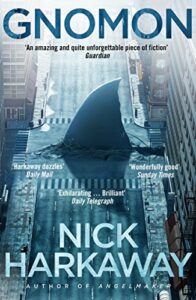Harkaway takes the epigraph for Gnomon from The Emperor by Ryszard Kapuscinski. “When the first question was asked in a direction opposite to the customary one, it was a signal that the revolution had begun.” Ethiopia, as portrayed in The Emperor is a land of whispers and intrigues, barely contending with modern technology, shaped by the personal rule of one man applied to a country of some thirty million. It nearly directly opposite to England with the System and the Witness.
Inspector Neith experiences imperial Ethiopia through the narrative of Berihun Bekele, a painter who was a young man in the waning days of Emperor Haile Selassie’s reign and a grandfather by the time of the story that Neith encounters. His granddaughter Annie is a brilliant technologist and is leading the development of an immersive computer game called Witnessed. The features of both the in-game world and the gameplay bear a close resemblance to Neith’s world of System and Witness. Is she seeing the early days of the world she knows? If she is, how did it get into Diana Hunter’s mind?
Inspector Neith also pursues the truth about Diana Hunter outside of the interrogation recordings, but the people she finds connected to the case are no less unsettling than the personas yielded up in the interrogation. One person, for example, turns up inside of Hunter’s house, which has been built as a Faraday cage, a place where the Witness cannot look. Neith encounters this person on subsequent occasions, and each time they seem to be invisible to Witness surveillance which is, at least in theory, ubiquitous. She talks to a person from an obscure corner of infrastructure governance who knows an improbable amount about interrogations such as Hunter’s; later Neith learns that the obscure agency also plays an important role in the Ethiopian narrative. Similar interactions with a bookseller, a technician who speaks of glitches in the System, a professor of semiotics and others point toward elements of Hunter’s various narratives and are pointed to by those same stories. Which way does the causation run? Is there any way to tell? Is there, in fact, a difference?
Neith finds herself drawn in deeper when one of her “real-world” interlocutors is murdered by something from within one of Hunter’s narratives. The event is impossible, and yet the evidence is incontrovertible. Moreover, it echoes an equally impossible killing inside another of Hunter’s narratives.
By this point, enough gnomons have burst in perpendicularly to make telling time by their shadows quite a challenge. Harkaway manages the act, showing events first in one light, then in another, with each flip of the switch casting a new illumination. It all comes together in the end of this hugely ambitious novel. It is not tied up in a bow, wrapped for the audience; instead, the lights converge leaving some things clear, others in shadow, with interpretation of the intersection of gnomon and plane ultimately up to the reader.

